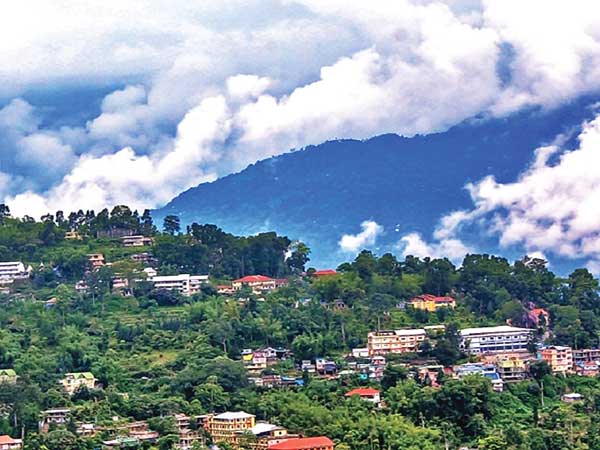
I had visited Kalim-pong soon after the West Bengal Tour-ism took over the splendid Morgan House and decided to make it a tourist getaway. I was requested to visit Kalimpong and suggest drapes and any necessary changes and needless to say, I jumped at the opportunity—Darjeeling I knew well, but Kalimpong was altogether a different story!
The drive to Kalimpong up the Teesta Valley from Siliguri was truly magical. The river seemed to change mood with every turn until we reached Teesta Bazaar, where we stopped for tea. It has its bi-monthly Haats and mixing with the locals and experiencing the traditional culture is never a problem. In Kalimpong— one can see modern and traditional mixing naturally in its own way. According to the driver besides Indian goods, a huge variety of stuff from Bhutan, Sikkim, Tibet and Nepal seem to filter in.
Located at a height of 1,247 metres (3,933 ft) above sea level, Kalimpong is just 51 km from Darjeeling and 70 km from Siliguri. Two National Highways 55 and 31a originating at Siliguri, will take you up to Darjeeling and Kalimpong. The distance is rather short, but it is important to note the differences in weather and atmosphere. Siliguri despite the fact that a number of tea gardens are located here, is totally urban with enough cars and trucks to make you want to get away as fast as possible. Darjeeling is colder, mistier more crowded and bustling, while Kalimpong does have its mists as well the temperature is seldom colder than 12-16 degrees. In summer on a sunny day, the temperature may rise to as high as 30 degrees.
Kalimpong is known to have originally been part of Bhutan. It was earlier called ‘Dalingkote’ by the Bhutias and was an important centre for Indo-Tibetan trade, being close to the important mountain passes of Nathu-la and Jelep-la. It was renamed when the British acquired the area after the Anglo-British War in 1864 and was raised to the stature of a sub-division in April 1916. With its mild climate, the British found Kalimpong to be a perfect location for a sanatorium. In the early days it was the weather that attracted British settlers and soon a main street “was laid out in correct boulevard style with rows of trees. “ at the time this street included Dr Graham’s Homes and a Gothic Church, to which a clock tower was added in 1891.
The British colony is said to have had 1200 members in 1916. With Kalimpong’s weather being a great attraction, their numbers continued to grow and so did the need for schools. A number of private schools planned on the lines of Eton and Harrow were created around the area, however, Kalimpong is best known for Dr Graham’s Homes, conceived as a home for underprivileged children created in 1900 by the Scottish Missionary Rev. Dr. John A Graham. It has been recorded that during Dr Graham’s lifetime, the ‘Homes’ had consisted of 35 buildings including cottages, schools, industrial and farm buildings, a hospital, a swimming bath and a park, where around 600 domiciled European and Anglo-Indian children of both sexes ranging from 2 years to 18 years, were educated.
These days, the Municipal offices are on a ridge overlooking the Teesta River as Kalimpong with its temperate climate, magnificent view of the Himalayan Range and proximity to popular tourist locations has become a popular tourist destination. There are many theories about the name Kalimpong. One theory claims that in Tibetan, the name means “Assembly (or Stockade) of the King’s Ministers” another theory is that the name is derived from the translation “ridge where we play” in Lepcha, as it is known as a place for tribal gatherings and summer sports. Kalimpong is home to Nepalis, Lepchas and other ethnic groups and is now a religious centre of Buddhism.
The first Buddhist Monastery to be built was the Thongsha Gumpa. The Tharpa Choling Monastery is in the centre of the city and a Bhutanese monastery on the 12 Mile Road, The Tibetan Buddhist monastery Zang Dhok Palri Phodang is known for a number of rare Tibetan Buddhist scriptures. However, it is important to note that even as early as in 1900s, there was a Mosque and a Hindu Temple in Kalimpong.
The Kalimpong Science Centre, established in 2008 is a recent addition, The Science Centre which provides the scientific awareness among the students of the town, while the locals spend more time atop the Deolo Hill, the highest point in Kalimpong.
But the most important aspect of Kalimpong has been kept till the last—a story that remains untold. Horticulture is important to Kalimpong, It has a splendid flower market notable for its wide array of orchids and nurseries that export Himalayan grown flower bulbs, tubers and rhizomes. Kalimpong is a major production centre for the popular flower Gladioli and some of India’s best orchids that are exported to many parts of the world,
Making waves of late is Kalimpong’s cactus cultivation. Its nurseries attract people from far and wide for the stunning collection of cacti that they have been cultivating. The strains of cacti, though not indigenous to the area, have been carefully cultivated over the years. The plants have adapted well to the altitude and environment, and now prove to be one of the chief draws of tourism
The best season for visiting Kalimpong is during spring. This is when orchids bloom wild on trees and the nurseries have their finest selection and their most exotic varieties in bloom. The other good time to visit is in October when Kalimpong’s Annual Flower Show is held.





